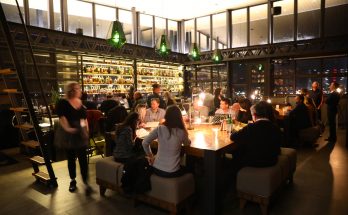This January, a wide-eyed, red-headed “little” orphan rolls into town — with a rich benefactor and a scruffy terrier in tow. Leaping lizards, Annie has arrived! Much of the action takes place in New York City, with Gotham’s gloss symbolizing hope and promise. Here, we present a tour of the Big Apple, as told through the lyrics and settings of Annie.
“. . . like the top of the Chrysler Building”
It’s a “Hard-Knock Life” for Annie and her friends in the orphanage, as the evil Miss. Hannigan exhorts them to scrub the floors until they sparkle like the crown of the glorious Art Deco masterpiece, the Chrysler Building, which was the tallest building in the world when it opened. Its distinctive stainless steel spire continues to be a beacon on the city’s skyline.
Other exterior decorative flourishes of the 1930 masterpiece include sculptures depicting car wheels and radiator caps — a homage to the tower’s original purpose as headquarters for the carmaker.
Inside, a symphony of rich burled wood and russet-hued marble awaits. This is the only part of the building open to the public — unless, of course, you’re conducting business upstairs.
” . . . today we’re living in a shanty”
After escaping from the orphanage — we won’t tell you how — Annie stumbles upon a “Hooverville,” one of many such homeless settlements that sprung up during the Depression. In “We’d Like to Thank You, Herbert Hoover,” the denizens sing an ironic song of gratitude for their dire straits. It’s not exactly the same thing, but New York’s Zuccotti Park, site of the original Occupy Wall Street encampment, is bound to become a tourist attraction.
Located in lower Manhattan, not far from Ground Zero, it’s a privately-owned park that remains open to the public. Of course, the tents are long gone, but that doesn’t mean the space — more of a plaza than anything else — isn’t a perfect place to sit and enjoy an al fresco sandwich or hot dog. Zuccotti Park also features two sculptures. The first is Joie de Vivre, a 70-ft. abstract in the signature red steel of Mark di Suvero; the other, Double Check, depicts a seated businessman cast in bronze, a very typical J. Seward Johnson work.
“No finger will you lift my dear …”
When Annie finds herself living in the home of billionaire Oliver Warbucks, she can’t help but proclaim “I Think I’m Gonna Like It Here!” The fictional Warbucks lived in the Upper East Side on Fifth Avenue. Although the mansion used to portray his home in the 1982 movie Annie is in New Jersey, you can get a feeling for how the one percent lived during the Depression by visiting the the Frick Collection.
Formerly the home of turn-of-the-century industrialist Henry Clay Frick, the Frick is a museum that features fine European paintings, 18th-century French furniture, and superb decorative arts like Oriental rugs and Limoges china. Visitors pass through art-adorned rooms with sumptuous wood panelling and magnificent ceiling murals before entering a glass-roofed courtyard that’s an oasis of serenity. When you’re done, Central Park is just across the street.
“What other town has the Empire State?”
In “NYC,” Warbucks serenades his little orphan friend with a paeon to the city’s riches. Chief among them: the soaring Empire State Building. The musical takes place in 1933, and both the Chrysler Building and the Empire State Building were new on the scene — imagine how glorious they must have seemed! Completed just 11 months after the Chrysler, the Empire State just barely wrested the title of world’s tallest building from it. Now it’s no longer even tallest building in the city, but it’s still one of Manhattan’s most-visited tourist attractions.
Its main attraction — the observation decks — are what kept its doors open during the Depression, when its office space was hard to lease. Visitors still queue up to peer over the decks on the 86th and 102nd floors. The lines are longest during lunchtime — so try first thing in the morning (8 a.m.), or last thing at night (1:15 a.m.). Or opt for an express pass, which whisks you to both floors for $55 (ages 6 and older).
” … the shimmer of Times Square”
In the same song, Warbucks refers to the great crossroads of America, Times Square — and boy does it shimmer. That’s intentional. All buildings lining the square are required to display some kind of neon pizzazz. Lucky for visitors, blocks fronting the area have been newly pedestrianized, so you can pile into the street and gawk without fear of being hit by a cab.
Of particular interest to theater lovers is the renovated TKTS booth, where you can purchase same-day discounted Broadway and off-Broadway tickets (though not all shows are available). The new booth has a brilliant, stage-worthy set of ruby red glass stairs that lead to a 16-ft. high panoramic view.
“Let’s go to the movies!”
This song was written for the 1982 film version of Annie, which premiered at Radio City Music Hall. Radio City is New York’s version of the Fox Theater. In fact, when it was built in 1932 to beat all movie palaces, its architects had the Fox — which was the world’s largest theater at the time — specifically in mind.
Dubbed the “showplace of the world,” Radio City seats nearly 6,000 (just a few more than the Fox), and features a giant projection screen and stage for live entertainment.
Its décor seems almost austere in comparison to Fox, but that was a deliberate response to the prevailing theater architecture of the time. As befits Art Deco’s design principles, Radio City’s swooping curves and lush materials are intended to do all the decorative work.
A Stage Door Tour is the best way to see it all: Tickets are $19.25 for adults, $15 for seniors and $12.50 for children under 12. And no matter what, make sure you sneak a peak at the astounding restrooms — they are boudoirs truly worthy of the Warbucks clan.



